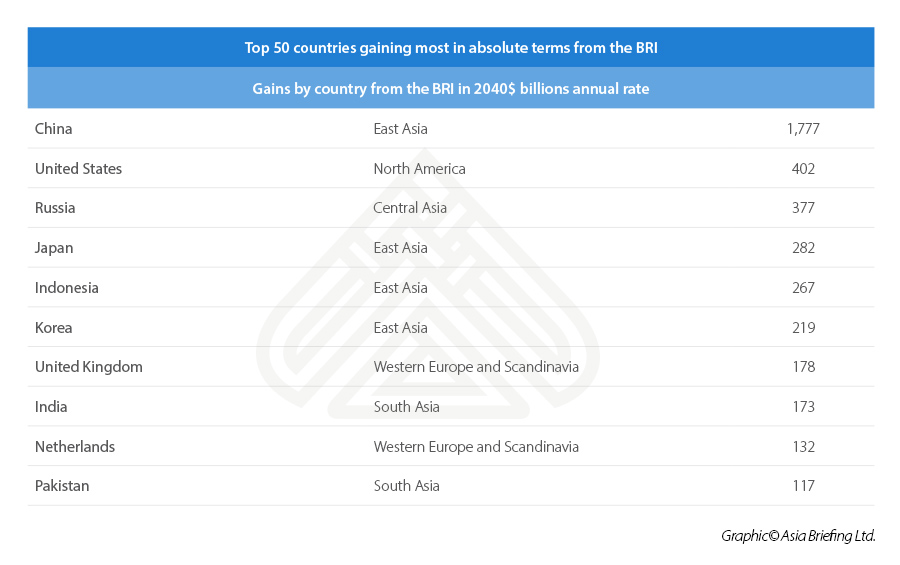The United States : The Second Largest Belt And Road Beneficiary After China
CEBR Issues Report Stating US Will Gain US$400 Billion From Chinese Global Belt & Road Infrastructure Improvements
A report issued by the UK based Centre for Economics and Business Research (CEBR) indicates that the United States, despite its criticism of China’s Belt & Road Initiative, is actually a beneficiary of the scheme.
The report, which was by Britain’s Chartered Institute of Building, looked at how infrastructure gains from the Belt and Road Initiative could boost productivity across the world. After factoring in trade frictions, the study found that the BRI could increase U.S. GDP by 1.4% by 2040.
Despite assuming zero direct involvement of the U.S. in the BRI, “the U.S. gains from the boost to world GDP are such that in absolute terms.” In fact, the researchers argued that “the U.S. is the second largest beneficiary. Our calculations suggest that the BRI will leave US GDP in 2040 US$401 billion higher, a boost of 1.4%.”
The BRI’s key driver for U.S. growth would be trade: Because of the U.S. economy’s size, the country can benefit “from the indirect effects of world GDP being boosted,” the researchers explained.
“We will expect U.S. exports to be delivered a boost through the kind of increased economic growth in some of the key external markets.” CEBR Senior Economist Pablo Shah has stated. “At the same time, imports were also likely to become cheaper because “transport developments and energy links and higher integration across countries outside of the U.S. would facilitate more efficient means of production, which would mean cheaper inputs for consumers.”
This, Shah argued, would boost consumption overall and stimulate the U.S. economy.
And while the increase may seem relatively small at 1.4%, the researchers assert that it’s relatively massive when compared to other countries because the absolute size of the U.S. economy is still such that this is more than the absolute boost to any other economy except China.
The report is not without its critics. Jonathan Hillman, senior fellow at the D.C.-based think tank Center for Strategic and International Studies (CSIS) says that “This report exaggerates the size — current and future — of China’s Belt and Road. “I am not aware of any reliable data suggesting that $2 trillion of projects are underway.”
Hillman added that the assumptions weren’t detailed enough, “which is why I wouldn’t take this estimate seriously.” Ultimately, the entire BRI — and the economic benefits expected to come from it — “all depends on whether the right projects are chosen and how they are delivered,” Hillman said. “In other words, quality matters. What the BRI’s biggest advocates tend to forget is that infrastructure projects, if done poorly, can destroy more value than they create.”
However the report does touch upon an issue at the heart of many debates about the building of Belt & Road Infrastructure, and suggests that this will impact on trade. Many commentators instead concentrate on the development cost. That debate has been taken up by Chris Devonshire-Ellis here on Silk Road Briefing, in his article The Belt & Road’s Business Secret – Cashflow Opportunities Come After Infrastructure Development –
Meanwhile, academics will continue the debate about the extent and where global GDP growth the Belt & Road Initiative will provide. Many American politicians will hate the fact that China is contributing in any way to US growth (which in fact it has been for the past two decades) and especially as it shows up Washington’s lack of infrastructure spend of its own – a crazy position to take when interest rates are so low. Such debates are to some extent navel gazing – the Belt & Road Initiative is and will continue to have an effect on growth, the only debate is really to what extent this will filter down into other economies.
Meanwhile, the American response has been to launch the Blue Dot network, a fairly lame response to China’s exporting of finance and infrastructure.
The CEBR report, “From Silk Road To Silicon Road – How The Belt & Road Initiative Will Transform The Global Economy” can be downloaded here.
Related Reading
- China Ignores United States Trade Threats, Energizes Trade Ties With Russia & ASEAN As Alternatives
- Trump Targets Belt And Road Initiative With US$60 Billion International Finance Development Corporation.
About Us
Silk Road Briefing is written by Dezan Shira & Associates. The firm provides strategic analysis, legal, tax and operational advisory services across Eurasia and has done since 1992. We maintain 28 offices throughout the region and assist foreign governments and MNC’s develop regional strategies in addition to foreign investment advice for investors throughout Asia. Please contact us at asia@dezshira.com or visit us at www.dezshira.com






